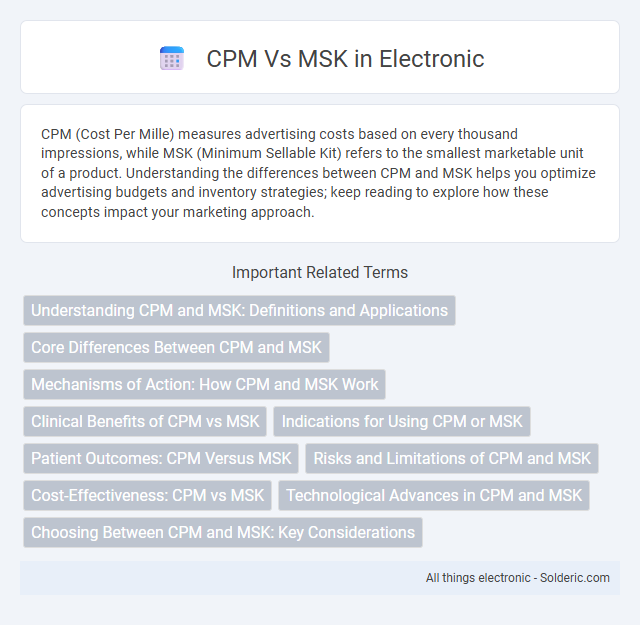CPM (Cost Per Mille) measures advertising costs based on every thousand impressions, while MSK (Minimum Sellable Kit) refers to the smallest marketable unit of a product. Understanding the differences between CPM and MSK helps you optimize advertising budgets and inventory strategies; keep reading to explore how these concepts impact your marketing approach.
Comparison Table
| Feature | CPM (Cost Per Mille) | MSK (Managed Streaming for Kafka) |
|---|---|---|
| Definition | Advertising metric measuring cost per 1000 impressions | Fully managed Apache Kafka service for real-time data streaming |
| Industry | Digital Advertising Marketing | Cloud Data Streaming, Big Data |
| Primary Use | Pricing model for ad campaigns and impressions | Real-time event streaming and data pipeline management |
| Key Metrics | Impressions, cost per 1000 views | Throughput, latency, message durability |
| Billing | Cost based on every 1,000 ad impressions | Pay-as-you-go based on resources and throughput |
| Target Users | Advertisers, marketers | Developers, data engineers, enterprises |
| Examples | Google Ads CPM campaigns | AWS MSK, Confluent Cloud MSK |
Understanding CPM and MSK: Definitions and Applications
CPM (Cost Per Mille) measures advertising cost per thousand impressions, optimizing budget allocation in digital marketing campaigns, while MSK (Minimum Segment Key) targets specific genetic markers in medical diagnostics to identify disease susceptibility. CPM is widely applied in online advertising platforms such as Google Ads for measuring ad visibility and engagement. MSK plays a crucial role in precision medicine by enabling early detection and customized treatment plans based on genetic profiling.
Core Differences Between CPM and MSK
CPM (Counts Per Minute) measures the rate of radioactive decay detected by a sensor, reflecting the number of ionizing events per minute, crucial for radiation monitoring. MSK (Musculoskeletal System Knowledge) pertains to the understanding of anatomy, function, and disorders of bones, muscles, and joints, important in medical diagnostics and treatment. The core difference lies in CPM quantifying radiation events for safety and research, while MSK encompasses the study of anatomical and physiological aspects of the musculoskeletal system.
Mechanisms of Action: How CPM and MSK Work
CPM (Continuous Passive Motion) promotes joint healing by gently moving the joint through a controlled range of motion, which enhances synovial fluid circulation and reduces stiffness. MSK (Musculoskeletal) treatments target muscles, bones, and connective tissues through therapies like manual manipulation, exercise, and modalities that reduce pain and improve function. Understanding the mechanisms of action behind CPM and MSK therapies can help tailor your rehabilitation plan for optimal recovery.
Clinical Benefits of CPM vs MSK
Continuous Passive Motion (CPM) therapy offers significant clinical benefits over Manual Shoulder Kinesis (MSK) by enhancing joint mobility, reducing postoperative pain, and accelerating cartilage healing. CPM devices maintain controlled, consistent movement, which minimizes joint stiffness and promotes faster recovery compared to the variable manual manipulation in MSK. Studies show CPM reduces inflammation and improves functional outcomes in patients undergoing shoulder surgery, making it a preferred option for rehabilitation.
Indications for Using CPM or MSK
Continuous Passive Motion (CPM) devices are primarily indicated for post-operative joint rehabilitation, especially after knee surgeries like total knee arthroplasty or ligament reconstruction, to enhance range of motion and reduce joint stiffness. Musculoskeletal (MSK) therapies are broadly applied for chronic pain management, injury recovery, and conditions such as arthritis, tendinitis, and muscle strains, focusing on improving functional movement and reducing pain through manual therapy, exercise, and other modalities. The choice between CPM and MSK interventions depends on the clinical goals, with CPM favored for controlled joint motion post-surgery, while MSK therapy suits a wider array of musculoskeletal disorders requiring active rehabilitation.
Patient Outcomes: CPM Versus MSK
Continuous Passive Motion (CPM) and Manual Stretching and Kneading (MSK) significantly impact patient outcomes in rehabilitation. CPM promotes joint mobility and reduces postoperative stiffness more consistently, leading to faster recovery times, while MSK enhances soft tissue flexibility and pain relief through targeted muscle manipulation. You may experience improved functional range of motion with CPM, whereas MSK can be more effective for addressing muscle tightness and promoting circulation.
Risks and Limitations of CPM and MSK
CPM (Critical Path Method) risks include inaccurate task duration estimates leading to flawed project timelines, while its rigid structure may overlook resource constraints and dynamic changes. MSK (Musculoskeletal) assessments face limitations as they can be subjective and dependent on the evaluator's expertise, potentially resulting in inconsistent diagnostics. Your project management or health evaluation approach should account for these risks to ensure effective decision-making and mitigation strategies.
Cost-Effectiveness: CPM vs MSK
Cost per mille (CPM) offers predictable budgeting by charging advertisers for every thousand impressions, making it cost-effective for brand awareness campaigns. Multiple Sclerosis Knowledge (MSK) platforms, while not traditionally measured by CPM, prioritize quality engagement and educational value, which may result in higher conversion accuracy but variable cost efficiency. Your choice between CPM and MSK depends on whether you aim for widespread exposure or targeted, meaningful interaction.
Technological Advances in CPM and MSK
Technological advances in CPM (Continuous Passive Motion) devices include programmable range of motion settings and biofeedback sensors that tailor therapy to individual patient recovery needs, enhancing joint mobility and reducing stiffness after surgery. In MSK (Musculoskeletal) treatments, innovations such as wearable exoskeletons and AI-powered diagnostic tools improve rehabilitation precision and early detection of musculoskeletal disorders. Integration of smart technology in both CPM and MSK therapies accelerates recovery times and optimizes patient outcomes through real-time monitoring and adaptive therapy protocols.
Choosing Between CPM and MSK: Key Considerations
Choosing between CPM (Continuous Passive Motion) and MSK (Musculoskeletal) treatment depends on your specific rehabilitation goals and injury type. CPM is ideal for post-surgical joint recovery, promoting faster mobility and reducing stiffness, while MSK focuses on broader musculoskeletal issues through physical therapy and pain management. Understanding your condition and desired outcomes will help determine whether CPM's automated joint movement or MSK's comprehensive care is best suited for your recovery.
CPM vs MSK Infographic

 solderic.com
solderic.com